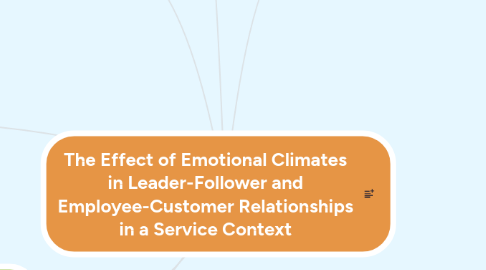
1. Company - Workers
1.1. Continuous positive appraisals
1.1.1. Internal Service Quality
1.1.1.1. Measured
1.1.1.1.1. Employee Feelings
1.1.2. Linkage Research Model
1.1.3. Should have
1.1.3.1. Leadership: Human resource management
2. Environment
2.1. Affects consumers and employees
2.1.1. Space/Function
2.1.2. Ambient conditions
2.1.3. Signs, symbols, and artifacts
2.1.4. Generates reactions
2.1.4.1. Cognitive
2.1.4.2. Emotional
2.1.4.3. Physicological
3. Climate
3.1. Result of organizational structure
3.1.1. Multi-level phenomenon that is stable over time and is integrated into a larger entity
3.1.1.1. Organizational Climate
3.1.1.1.1. A concept on group level
3.1.1.2. Psychological Climate
3.1.1.2.1. Individual's Perception
4. Consequences
4.1. Profit
4.2. Growth
4.3. Customer Satisfaction
4.4. Good Working Environment
4.5. High quality of products and services
5. The Service - Profit Chain
5.1. Employees Productivity
5.2. Employee Satisfaction
5.3. Loyalty
5.3.1. Employees
5.3.2. Customers
5.4. Organization's Profitability
6. Emotional Climate
6.1. Terminology
6.1.1. Emotions
6.1.1.1. Temporal, concrete, single incidents of several other mental states that bear similarity.
6.1.2. Affect
6.1.2.1. Synonymously for emotion, or as an umbrella term for emotion and related emotional states.
6.1.3. Feeling
6.1.3.1. The subjective experiential quality of an emotion.
6.1.4. Mood
6.1.4.1. Non-intentional, global or diffuse affective state, that is described as long lasting but low in intensity
6.2. Emotional Contagion
6.2.1. Individual's emotional experience is influenced by their own physiological feedback
6.2.1.1. Primitive emotional contagion's
6.2.1.1.1. Central Nervous System
6.2.1.2. Receiver of Emotion
6.2.1.3. Sender of Emotion
6.3. Comparison Processes
6.3.1. Need for affiliation
6.3.1.1. Individuals use others that bear a certain similarity to the focal individual for comparison purposes
6.3.1.1.1. Emotional similarity hypothesis
6.3.2. Conscious emotional convergence
6.3.2.1. Individuals have the ability to successfully interpret the emotional displays of others, independent from cultural backgrounds
6.3.2.1.1. Modeling
6.3.2.1.2. Social Influence
6.3.2.1.3. Empathy
6.3.2.1.4. Reciprocity
6.4. Effects of Mood and Emotion
6.4.1. Perception and attention
6.4.1.1. Emotionally relevant information
6.4.1.2. Perceived much faster and receives more attention
6.4.1.3. Mood consistent
6.4.1.4. Positive emotional climate
6.4.1.5. Positive affects in an employee
6.4.1.6. Positive appraisals of a given work environment
6.4.1.7. Subsequent positive outcomes
6.4.2. Memory
6.4.2.1. Material that is consistent with current affective state
6.4.2.2. Resulting positive appraisals and experiences will be recalled more easily, and more frequently.
6.4.2.3. Negative emotional displays
6.4.2.4. Negative emotional climate for followers
6.4.2.5. Lower job satisfaction
6.4.2.6. Lower quality of work life
6.4.2.7. Lower willingness to act entrepreurially
6.4.3. Information Processing
6.4.3.1. Positive emotions in employees and customers
6.4.3.2. Positive Halo
6.4.3.3. Negative aspects of the work environment, or the service encounter
6.4.3.3.1. Outshined
6.4.3.3.2. Overlooked
6.4.3.3.3. Depreciated
6.4.4. Judgments
6.4.4.1. Individual's current affective state is often used for judgments
6.4.4.2. Positive affects in employees
6.4.4.2.1. Positive perceptions of workrelated quality of life
6.4.4.2.2. Return to the store just to relieve the positive experience
6.4.4.3. Higher satisfaction appraisals
6.4.5. Consumer behavior and satisfaction
6.4.5.1. Treating a company's employees as internal customers
6.4.5.2. May appraise their work environment more favorably
6.4.5.2.1. Effect in

